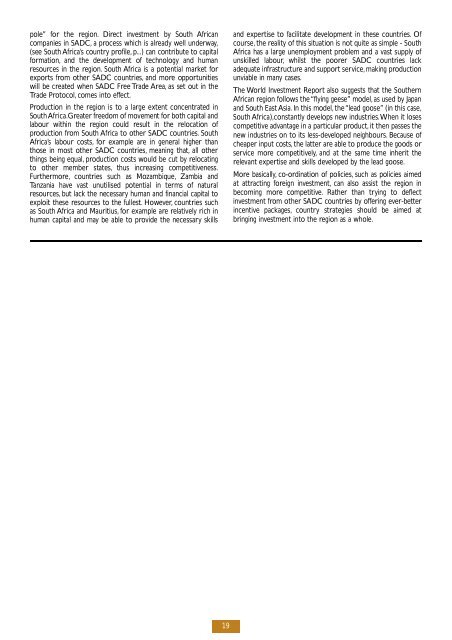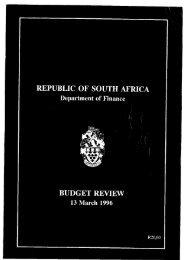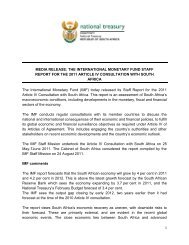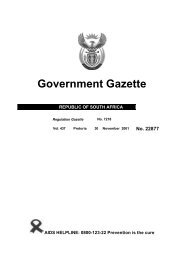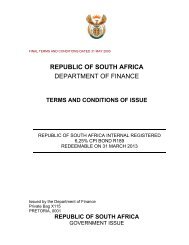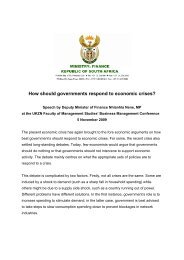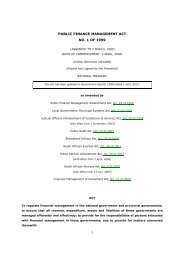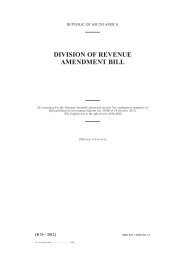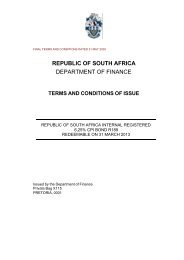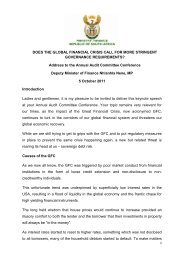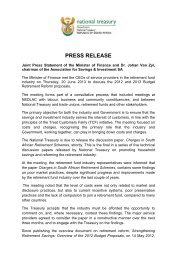1998 SOUTHERN AFRICA ECONOMIC ... - National Treasury
1998 SOUTHERN AFRICA ECONOMIC ... - National Treasury
1998 SOUTHERN AFRICA ECONOMIC ... - National Treasury
You also want an ePaper? Increase the reach of your titles
YUMPU automatically turns print PDFs into web optimized ePapers that Google loves.
pole” for the re g i o n . D i rect investment by South A f r i c a n<br />
companies in SADC, a process which is already well underway,<br />
(see South A f r i c a ’s country pro f i l e, p...) can contribute to cap i t a l<br />
fo r m a t i o n , and the development of technology and human<br />
re s o u rces in the re g i o n .South Africa is a potential market fo r<br />
e x p o rts from other SADC countries, and more opport u n i t i e s<br />
will be created when SADC Free Trade A re a ,as set out in the<br />
Trade Pro t o c o l ,comes into effe c t .<br />
P roduction in the region is to a large extent concentrated in<br />
South A f r i c a .G reater freedom of movement for both capital and<br />
labour within the region could result in the relocation of<br />
p roduction from South Africa to other SADC countries. S o u t h<br />
A f r i c a ’s labour costs, for example are in general higher than<br />
those in most other SADC countries, meaning that, all other<br />
things being equal, p roduction costs would be cut by re l o c a t i n g<br />
to other member states, thus increasing competitive n e s s .<br />
F u rt h e r m o re, countries such as Mozambique, Zambia and<br />
Tanzania have vast unutilised potential in terms of natural<br />
re s o u rc e s ,but lack the necessary human and financial capital to<br />
exploit these re s o u rces to the fullest. H oweve r, countries such<br />
as South Africa and Mauritius, for example are re l a t i ve ly rich in<br />
human capital and may be able to provide the necessary skills<br />
and expertise to facilitate development in these countries. O f<br />
c o u r s e, the reality of this situation is not quite as simple - South<br />
Africa has a large unemployment problem and a vast supply of<br />
unskilled labour, whilst the poorer SADC countries lack<br />
adequate infrastructure and support serv i c e,making pro d u c t i o n<br />
u nviable in many cases.<br />
The World Investment Report also suggests that the Southern<br />
African region fo l l ows the “ f lying geese” model,as used by Jap a n<br />
and South East A s i a .In this model,the “lead goose” (in this case,<br />
South A f r i c a ) ,c o n s t a n t ly develops new industries.When it loses<br />
c o m p e t i t i ve advantage in a particular pro d u c t ,it then passes the<br />
n ew industries on to its less-developed neighbours. Because of<br />
c h e aper input costs, the latter are able to produce the goods or<br />
s e rvice more competitive ly, and at the same time inherit the<br />
re l evant expertise and skills developed by the lead go o s e.<br />
M o re basically, c o - o rdination of policies, such as policies aimed<br />
at attracting fo reign inve s t m e n t ,can also assist the region in<br />
becoming more competitive. Rather than trying to deflect<br />
i nvestment from other SADC countries by offering eve r- b e t t e r<br />
i n c e n t i ve packages, c o u n t ry strategies should be aimed at<br />
bringing investment into the region as a whole.<br />
19


